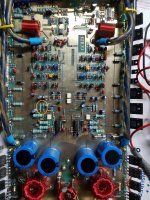This amp appears to have a fully isolated secondary. Find the two speaker terminals that are directly connected (0 ohms between them and use that for the reference point for the following voltage readings.
±rail
±regulated
Voltage on all 3 terminals of the J111 muting transistors. They are likely Q101 and Q201. If they're a different part number, what is it?
±rail
±regulated
Voltage on all 3 terminals of the J111 muting transistors. They are likely Q101 and Q201. If they're a different part number, what is it?
Rail voltage is: ±38.95
As to ±regulated, I'm not sure what/where exactly you are asking me to check the voltage on...?
The components in the Q101 and Q202 location are MBS4993 bidirectional switches.
Q101 DC voltage:
MT1: -1215v
G: -12.88v
MT2: -12.95
Q201:
MT1: -13.06v
G: -13.72v
MT2: -13.84v
As to ±regulated, I'm not sure what/where exactly you are asking me to check the voltage on...?
The components in the Q101 and Q202 location are MBS4993 bidirectional switches.
Q101 DC voltage:
MT1: -1215v
G: -12.88v
MT2: -12.95
Q201:
MT1: -13.06v
G: -13.72v
MT2: -13.84v
Check the regulated voltage on the PS pins of the op-amps.
Check the various flameproof (dull, ceramic coated) resistors in the amp. Most are low value and can be checked in the circuit.
Check the various flameproof (dull, ceramic coated) resistors in the amp. Most are low value and can be checked in the circuit.
Regulated voltage is ±15v (pins 4 and 8) op-amps are BA4560
All the flame proof resistors check good with the exception of the two circled in the attached photo. Both are of the same value but are giving quite different ohm readings. They are also both getting very hot when the amp is powered up.
All the flame proof resistors check good with the exception of the two circled in the attached photo. Both are of the same value but are giving quite different ohm readings. They are also both getting very hot when the amp is powered up.
Attachments
Last edited:
See also #27.
Before you reassemble this amp, heat the terminals of the PS filter caps and make sure that there is no smell of electrolyte.
Before you reassemble this amp, heat the terminals of the PS filter caps and make sure that there is no smell of electrolyte.
If the power supply filter capacitors are original (2200uF 16V Panasonic HF) you should exchange them, they all leak, always.
D321 and D322 both check good.
The PS filter caps had leaked electrolyte all over that section of board. Prior to me even starting this thread, the first thing I did to this amp was to remove those caps thoroughly clean the board ad replace them.
The PS filter caps had leaked electrolyte all over that section of board. Prior to me even starting this thread, the first thing I did to this amp was to remove those caps thoroughly clean the board ad replace them.
You had pulsing across one of the LEDs previously. Do you have pulsing DC on either channel?
Have you go through an checked the transistors throughout the amp to at least see if any were shorted?
Have you go through an checked the transistors throughout the amp to at least see if any were shorted?
As I was going though checking the transistors in the right channel I found one of the 51ohm resistors was shorted open. I replaced it and regained power on that channel. I then checked the resistors in the left channel and found it also had one of the 51ohm resistors shorted open. Amp is now powering up and functioning as it should.
- Home
- General Interest
- Car Audio
- Phoenix Gold MS-2125 no rail voltage

